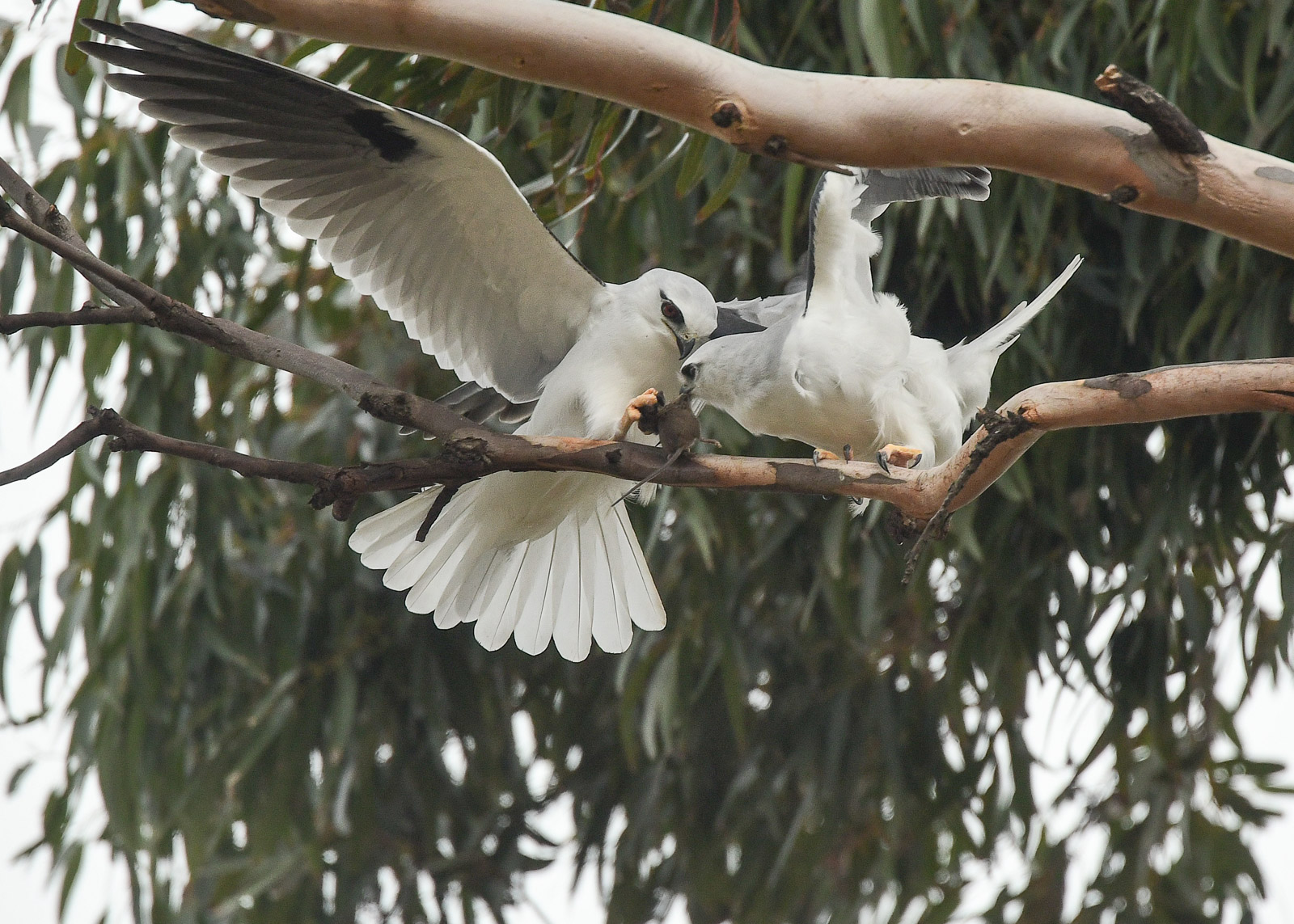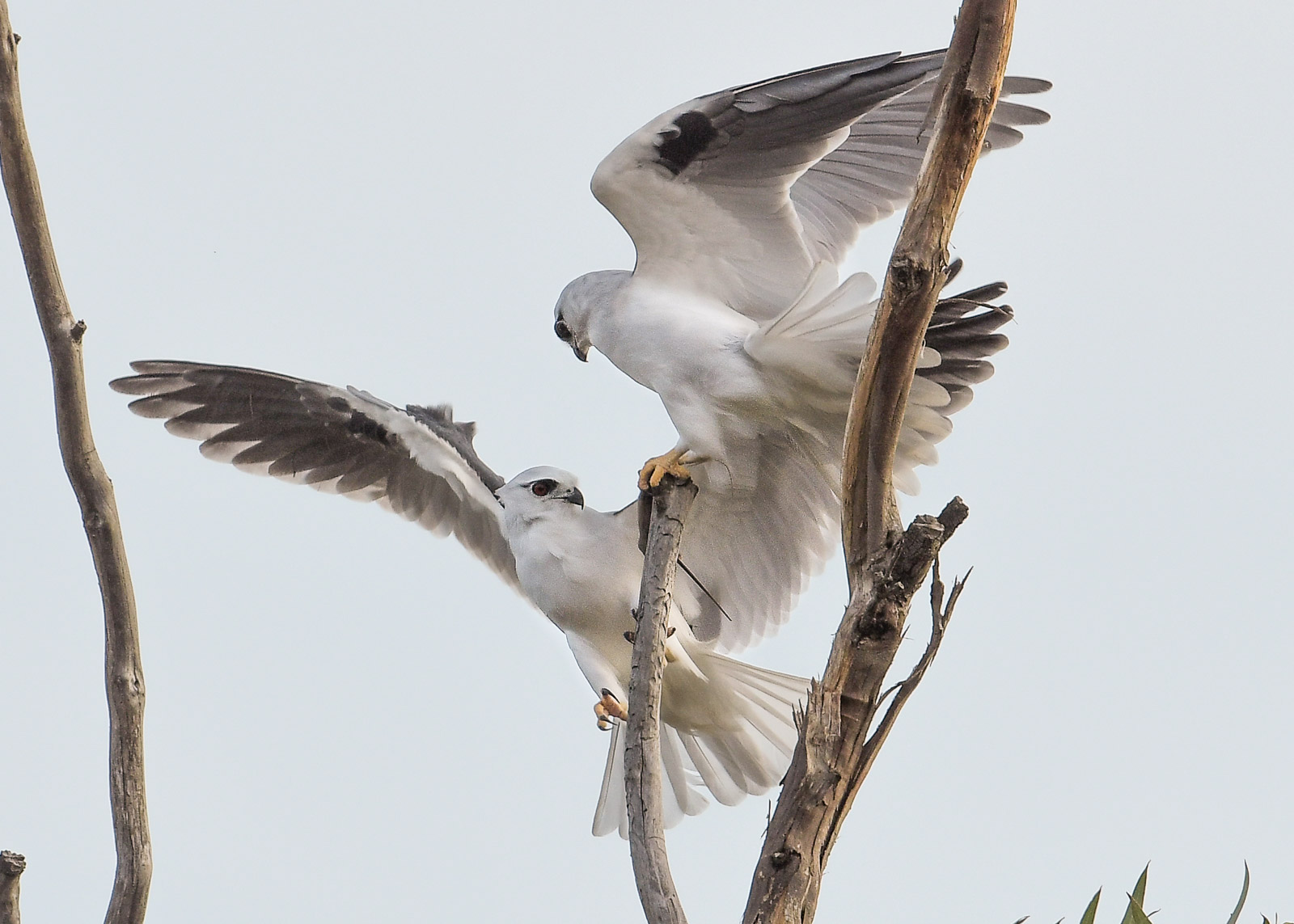Regular followers will know that not too far from home, in a quiet roadside reserve, we have over the years been following the nesting activities of a pair of Black-shouldered Kites, named, Belle and Bronson.
If the boy scout arithmetic is close to correct, (and a lot of covid-lockdown not withstanding), it’s likely the that pair over about 4 years had as many as 10 successful clutches and two that were abandoned for various reasons.
Each clutch on average was 3 young birds, with two being just 2 young. All seemed to survive to leaving home, so its possible between them they flew at least 28 young birds to add to the population.
There is some anecdotal evidence that Belle had a least two Bronsons. Which would make her quite an old bird in Black-shoulded Kite years.
In September 2022, they again flew in sticks and mated and she settled in to the job of her 11th clutch.
But.
The weather turned dreadful not long after she had layed the eggs, and we had over a week of incessant rain and extreme high winds. We had watched the branch carrying its precious cargo being tossed about like a leaf.
After about a week, Belle disappeared. The nesting was over. We’ve seen her do this before and usually after bulking up for 2-3 weeks, she’d return.
Time, as they say went by, and no sign of return.
Bronson was still home-schooling his previous two young. They were pretty much full grown and self-sufficient, but they stayed around the home tree, and he sat with them for a couple more weeks, eventually they too left and the paddock and small treeline was bare of Kites.
All through October and November, we kept checking, but in the end it was obvious. This party was over.
We did make occassional visits, but all through till March there was no further activity.
I had been following a second pair of Kites about a kilometre down the road, so a drop in wasn’t too hard.
In early April, we heard familiar sounds of a Kite short squeaking call. All excited, perhaps the pair were back. However we only found one and it certainly wasn’t from the missing pair.
A few days later a second one was visible. This one certainly was a much younger bird and we wondered if they were a pair.
Hard to tell, initially. They certainly didn’t behave like the originals and they had some unusual habits. Including not using any of the more familiar perches and spending time at the far end of the little plantation. Also it soon became clear that they did not engage in aerial transfer of food. And to be honest, watching them try to transfer on a branch showed how clumsy either, one, or both of them were. Eventually they settled on using the large street lights over the freeway as a level table to pass the mouse across. Strange.
The upside was the work, began, a site was settled on, and settled into. Stick carrying, and mating were the order of the day. Inspite of their clumsy food transfering, the mating seemed to go quite well, thank you.
I’ve delayed writing about it, and showing some pictures as it’s been very much an on-again off-again process. We think of them as ‘new age’ birds that have a new set of rules. 🙂










Enjoy

A fabulous series of images, David! I haven’t had much time with them but they do behave very differently to the original B & B. Great to have them in the area. And here’s hoping that they stay for a while!
LikeLiked by 1 person
G’day David,
They certainly are a different acting pair from the earlier birds. Neither have much human tolerance and the male is quite ready to swoop all and sundry passing by.
Looks like she has managed to hatch as she is now feeding from the edge of the nest, so the next week or so should see what is in the offing.
It’s possible to see the nest from way out on the Fed Bike Trail.
LikeLike
Aw… I wonder what’s happened to Belle… Perhaps she was distressed that the storm brought about the loss of her eggs, and – heartbroken – she’s moved right out of the district… Perhaps???
However, a lovely series of photos recording the challenges that the New Kids On The Block had passing the Catch Of The Day from one to the other. (Most intriguing that a mid-air transfer of a Catch didn’t come naturally – or perhaps their parents never got around to teaching them…!)
Anyway, a delightful Post thanks David with beautiful photos and interesting explanations to go with those photos…
On a different matter: I’ve just posted a Comment on your previous publication (The one that was supposed to feature the Gannets but ended up featuring Raptors), but – unless the Comment shows up some time after it’s been posted – it looks as if it hasn’t been recorded… Hopefully, this one will be…! 🙂
Thanks for the interesting Blog my friend…!
LikeLiked by 1 person
Hi Lance, thanks for the thoughts.
I suspect that Belle, reached her use by date and succummed to the cold and the wind.
The age of Black-shouldered Kites is not well documented, but the best average seems to be about 5-6 years. We had seen her for at least 4 years and as she wouldn’t start to breed until at least 1year old, her time must have been getting close.
Not a nice thought. She certainly did her part for the species.
In about the 2nd year we think she changed partners. Took on a much younger male. At first she had definite ideas and he had a lot to learn, but about the third clutch together they were a well-oiled machine.
Young birds spend quite a lot of time for about two weeks, learning the aeriala food transfer skills. I am pretty sure it is Belle II that has the problem with the exchange. He can come in and call and sit for up to 20 minutes or more before she makes any attempt to retrieve the offering.
Then its almost always on the light pole on the roadway.
I’m not sure what goes with WordPress. I’ve asked a number of times and no answer seems to provide a permanent solution. I know I have trouble commenting on other sites from time to time.
LikeLike
Thanks for the informative reply David…! Greatly appreciated…!
LikeLike
The original Comment still hadn’t turned up, so I tried to send a second version of it and the Site told me I’d already written that…! And now it’s turned up, so I guess it’s a case of “Better late than never…!!!” :-))
LikeLiked by 1 person
Hi Lance. Yes it did show up
Not sure what WordPress is doing. All good now
LikeLike
Sad that your original Belle has not returned, but good luck to the new pair. Your photographs of them are wonderful.
LikeLiked by 1 person
Thanks Eleanor, as I said in my reply to Lance, above, it is highly likely that the energy required to lay eggs and hatch them combinded with the atrocious weather of that time that she might have passed.
Else no doubt Bronson would have stayed in the area until her return.
These ones are completly different and its quite a challenge to try and work out what their methods are.
Hopefully she’ll be successful and will settle into the area.
LikeLiked by 1 person
Great captures and story David. Yes this couple are doing things differently, and as you mentioned this has some similarity to the youth of our modern age. Passing the mouse was a complex issue, so some inexperience appears to be present in the female. It is lovely that you have such a group of regular and predictable nesting raptors. Our local birders, along with us, have not seen the Powerful Owl male for a week, which has us all thinking and concerned. Hope the weather is not to harsh, we have had some beautiful Winter days this last week.
LikeLiked by 1 person
Hello Ashley, thanks for the comments and insights.
We have this pair and another at the moment that seem to have completley different operating methods to most of the kites we’ve previously worked with. One pair have been on again and off again since about Janurary.
I do feel that any awkwardness of food exchange is with the female. She sometimes fumbles the exchange on the light pole. They worked on an aerial the other day, but in the end she landed on the light and waited for him to bring the mouse there. Strange behaviour.
I don’t have much experience with Powerful Owls so its hard to know what might be going on. We had a pair in the parks in the heart of Melbourne City, and the parks people had to go round each morning and remove any left over possum pieces so people wouldn’t be concerned by the carcasses laying about
But they used to move from tree site to tree site, sometimes about 2 km away.
The weather is making it hard for photography. Each day is overcast and flat. We might get short bursts of sunshine, but most of the time, the Doona is my preference.
Keep takin’ picures. We do
LikeLiked by 1 person